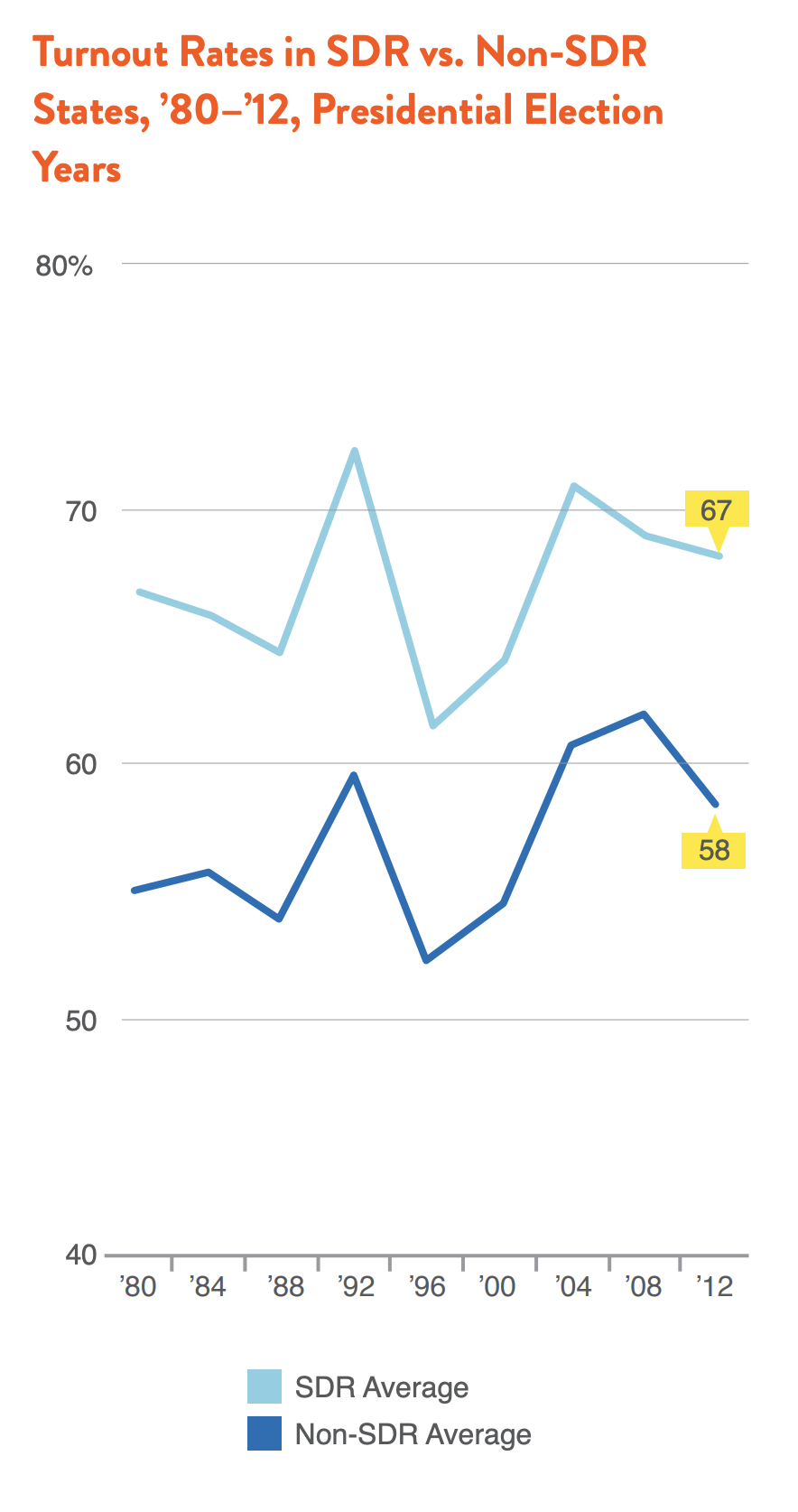Same-Day Registration (SDR) allows eligible voters to register to vote and cast their ballots on the same day. Depending on the state, this one-stop process for registering and voting may be offered on Election Day, during the early voting period, or both. Eligible voters can also use Same-Day Registration to correct an outdated voter registration record and cast a ballot that will be counted. Pioneered by Maine, Minnesota, and Wisconsin in the early-to-mid-1970s, fifteen states (California, Colorado, Connecticut, Hawaii, Idaho, Illinois, Iowa, Maine, Maryland, Minnesota, Montana, New Hampshire, North Carolina, Wisconsin, and Wyoming) and the District of Columbia have now enacted the reform.
The Benefits of Same-Day Registration
Eligible voters can also use Same-Day Registration to correct an outdated voter registration record and cast a ballot that will be counted. Pioneered by Maine, Minnesota, and Wisconsin in the early-to-mid-1970s, fifteen states (California, Colorado, Connecticut, Hawaii, Idaho, Illinois, Iowa, Maine, Maryland, Minnesota, Montana, New Hampshire, North Carolina, Wisconsin, and Wyoming) and the District of Columbia have now enacted the reform.
- Increases voter turnout. States that allow Same-Day Registration consistently lead the nation in voter participation. Four of the top five states for voter turnout in the 2012 presidential election all offered Same-Day Registration. Average voter turnout was over 10 percentage points higher in SDR states than in other states.
- Eliminates arbitrary deadlines that cut off registration when voters are most interested. Many citizens become most interested and engaged with elections in the last few weeks before Election Day, when candidate debates and campaigns reach their peak. But registration deadlines may already have passed at that point. Many states unnecessarily close voter registration 25 to 30 days before an election.
- Remedies inaccurate voter rolls. Many previously-registered voters lose their eligibility merely because they have moved. Others are never added to the voter rolls because of bureaucratic errors. Failure to discover these problems prior to Election Day, when registration deadlines have passed, results in eligible citizens losing their vote. With Same-Day Registration, these voters can simply update registration records or register anew at the polling place and vote a ballot that will be counted.
- Assists geographically mobile, lower-income citizens, young voters and voters of color. Keeping voter registration records current is a big challenge under current systems, which place the onus of updating records on the individual. Census data show that over 36 million people in America moved between 2011 and 2012, and nearly half of those moving had low-incomes.
- Experts predict that Same-Day Registration can be particularly effective in increasing voter participation among voters of color. That prediction was borne out in North Carolina. Though they represented 20 percent of the voting-age population, African Americans comprised 36 percent of those who used SDR to vote in the 2008 presidential election in North Carolina, the first such election when SDR was available there.
- Greatly reduces the need for provisional balloting. Provisional ballots are offered to citizens who believe they are registered but whose names do not appear on voter rolls. But more than one in four such ballots cast in the 2008 presidential election were subsequently rejected. Allowing eligible voters to register and vote on the same day greatly reduces the need for provisional ballots, helping to assure voters that their ballots will be counted, and saving elections officials the time and expense of processing many provisional votes.
- After SDR was adopted in Iowa, provisional ballots dropped from 15,000 in the 2004 presidential election to less than 5,000 in 2008—a 67 percent decline. North Carolina saw 23,000 fewer provisional ballots after it adopted SDR in 2008.
A Cost-Effective and Secure Way Increase Voter Participation
- Iowa and North Carolina reported minimal costs to introduce SDR in the 2008 presidential election. The first presidential election when Same-Day Registration was offered in Iowa and North Carolina was in 2008. The state of Iowa spent less than $40,000 to introduce SDR for its 99 counties. County expenses were also minimal. North Carolina’s counties cited some additional staffing needs at voting sites as the most notable expense associated with Same-Day Registration.
- SDR costs are minimal in long-standing SDR states. In a telephone survey conducted by Demos of local election officials in Idaho, Maine, Minnesota, New Hampshire, Wisconsin, and Wyoming, most respondents described the incremental cost of SDR as “minimal.”
- Elections administrators agree that SDR does not compromise the integrity of the vote. The great majority of local elections officials in SDR states who participated in two Demos surveys reported that current fraud-prevention measures suffice to ensure the integrity of elections. SDR states impose heavy penalties for voter fraud; voters are required to show proof of residency; and voters must sign an oath attesting to their identity and citizenship. And unlike registration by mail, SDR requires eligible voters to attest to their identity face-to-face before an elections official. Election audits, with strict penalties for violations, add an additional level of verification.
